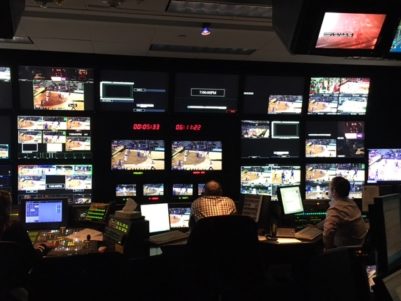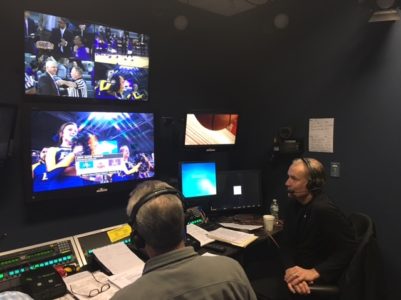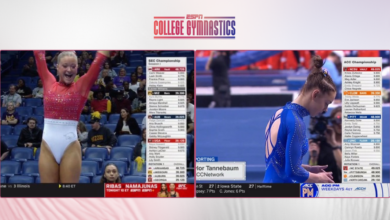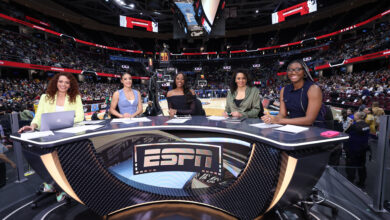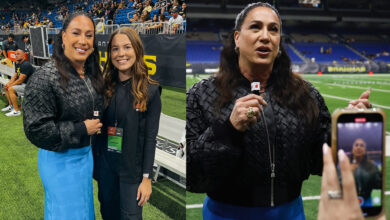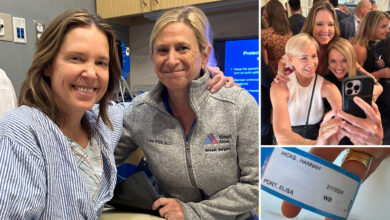Remote integration serves as another example of ESPN “working smarter”
ESPN continues to innovate and elevate, especially when it comes to live event coverage. This season’s college basketball programming schedule — with a record 3,200 games across ESPN networks — is no exception.
As the company looks to stay ahead of the ever-changing technological landscape, ESPN has expanded its remote integration telecasts for men’s and women’s college basketball this season. Games are being produced and called from production facilities at its Bristol, Conn., headquarters. In an effort to super-serve the fan with more games than ever before, facilities are also being used at ESPN’s Charlotte, N.C., studios and the ESPN Wide World of Sports Complex in Orlando, Fla.
The schedule of more than 90 games this season across 18 Division I conferences allows ESPN to reinvest in resources to make productions bigger and better.
ESPN Vice President, Remote Production Operations, Chris Calcinari, says, “Working smarter has allowed for innovations and enhancements this past year that include the development of PylonCam for college football and Monday Night Football, the first “live” use of a camera-equipped drone on X Games, live K-Zone on Major League Baseball telecasts and the Virtual 3 3-point line on NBA games. We are constantly testing and working to develop new tools that help differentiate and improve our productions.”
– ESPN VP, Remote Production Operations, Chris Calcinari
ESPN benefited from key learnings a year ago in its basketball telecasts and has applied them to better support and train the field teams on the nuances of remote integration events.
How does this model affect the way fans watch at home? Calcinari says, “Camera feeds, replays, animations, graphics, music and commentary are all integrated in a seamless manner, without impact to the viewing experience. The reduction of people and equipment onsite to one of our control rooms in Bristol, Charlotte or Orlando allows our staff to produce a show like they would if they were in a mobile unit on location.”
From an ESPN control room in Bristol’s Digital Center, Brian Boyle is preparing to produce the Tulsa-East Carolina game. His approach for this game is very similar to what it would be like on the road, as he settles in a few hours before tip.
“You do miss that face-to-face interaction you would get onsite, but through the audio communication with those needed to put on the telecast, we just emphasize the points you would normally do in person,” Boyle said. “It is a little different work flow, but it can all get done in a different way.”
The commentators – veteran play-by-play voice Bob Picozzi and analyst Tim Welsh – are calling the game from an audio booth in Building 1, along with their talent stats guru Dave Fried. The room has several monitors featuring different camera angles from Williams Arena at Minges Coliseum on the East Carolina campus in Greenville, N.C.
– ESPN college basketball analyst Tim Welsh
As Picozzi and Welsh go over their notes, they both comment on how the broad preparation is the same for a remote integration game. Welsh connects with his network of coaches, watches tapes and goes over the statistics. He says, “You have to make up for the conversations you have with the coaches and players during shoot-around, and to help with that, we have a conference call with each coach the day before – which is a positive, you just need to be prepared with questions since you only have him for a brief time. Once the game starts, it is just another game that we are calling.”
He continues, “We need to make sure we get our energy up – we are in a closed space. When you work with someone like Bob, he lifts the whole broadcast, and I follow his lead. I am here to comment on the plays, so from that end, I am not going to change anything.”
For Picozzi, one of the challenges of not being on site is wanting to be able to feel the energy in the building. Fortunately, sounds from the arena in his headset helps alleviate that challenge. He comments that as an announcer, “you feed off that energy and it helps energize you through the game, but it obviously depends on the venue and the hometown fans.”
Picozzi recalls a triple-overtime game that was part of the remote integration schedule. “In the third overtime, a very good friend of mine, a former coach who used to be an analyst, texted me and said, ‘you sound great’. I replied back asking him if he realized I am doing the game from the Bristol studios. He was shocked. So, if a person in the business that really sees the game with a watchful eye couldn’t tell, then I would say the average viewer couldn’t either.”
While ESPN has used remote integration for soccer, tennis, X Games and international basketball over the last few years, other networks have emerged with their own technologies.
This execution requires significant teamwork and communication across a variety of departments: Remote and Studio Operations, Technology and Production among them. Calcinari adds, “It’s really shining example of how the company pulls together across many areas to get behind a project.”
And Picozzi finishes by saying, “Pulling into my driveway tonight at 9:30 p.m. – living only 13 miles from ESPN’s campus – is an extra bonus!”

